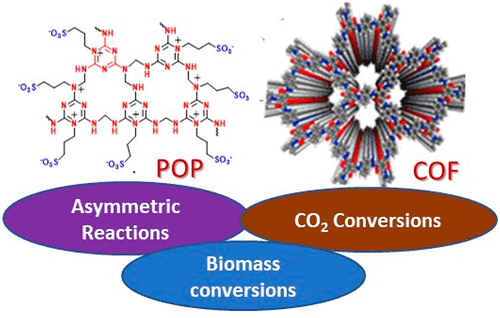当前位置:
X-MOL 学术
›
ACS Sustain. Chem. Eng.
›
论文详情
Our official English website, www.x-mol.net, welcomes your feedback! (Note: you will need to create a separate account there.)
Cross-Linked Porous Polymers as Heterogeneous Organocatalysts for Task-Specific Applications in Biomass Transformations, CO2 Fixation, and Asymmetric Reactions
ACS Sustainable Chemistry & Engineering ( IF 8.4 ) Pub Date : 2021-08-31 , DOI: 10.1021/acssuschemeng.1c01537 Arindam Modak 1 , Anindya Ghosh 2 , Akshay R. Mankar 1 , Ashish Pandey 1 , Manickam Selvaraj 3 , Kamal Kishore Pant 1 , Biswajit Chowdhury 2 , Asim Bhaumik 4
ACS Sustainable Chemistry & Engineering ( IF 8.4 ) Pub Date : 2021-08-31 , DOI: 10.1021/acssuschemeng.1c01537 Arindam Modak 1 , Anindya Ghosh 2 , Akshay R. Mankar 1 , Ashish Pandey 1 , Manickam Selvaraj 3 , Kamal Kishore Pant 1 , Biswajit Chowdhury 2 , Asim Bhaumik 4
Affiliation

|
Metal-free catalysis is particularly challenging in the context of green and sustainable chemistry. High toxicity associated with the leaching of the metals from the catalysts has notorious environmental impact. To surmount such an effect, homogeneous organocatalysis can provide a green and alternative protocol. However, it suffers the drawbacks of low activity and selectivity, because of the neighboring effect of the solvent, and it is devoid of recyclability for sustainable operations. To address such issues, solid-supported heterogeneous organocatalysts are developed, and these have been attracting increasing interest over the years. Multifunctional porous organic materials are very demanding in catalysis, because of their robustness in the structure involving strong covalent bonds between organic building blocks. Furthermore, their high specific surface area, topological diversity, and finely dispersed catalytic sites in nanoscale could make these porous organic materials as excellent scaffold for several task-specific applications. Lightweight and high inherent porosity, as well as structural stability with tenability of the active functional groups, have reinforced their tremendous potential as solid organocatalyst. In this Perspective, we highlight the latest advancements in metal-free cross-linked amorphous porous organic polymers (POPs) and crystalline covalent organic frameworks (COFs), their design principle to incorporate catalytic sites for major applications such as biomass conversion, biofuel synthesis, asymmetric organocatalysis, and CO2 fixation reactions. Several renewable and sustainable catalytic transformations could be achieved via environmentally benign pathways through this alternative metal-free approach.
中文翻译:

交联多孔聚合物作为多相有机催化剂,用于生物质转化、CO2 固定和不对称反应中的特定任务应用
在绿色和可持续化学的背景下,无金属催化尤其具有挑战性。与从催化剂中浸出金属相关的高毒性具有臭名昭著的环境影响。为了克服这种影响,均相有机催化可以提供一种绿色的替代方案。然而,由于溶剂的邻近效应,它具有活性和选择性低的缺点,并且缺乏可持续操作的可回收性。为了解决这些问题,开发了固体负载的多相有机催化剂,并且这些年来吸引了越来越多的兴趣。多功能多孔有机材料在催化方面的要求非常高,因为它们在涉及有机结构单元之间强共价键的结构中具有稳健性。此外,它们的高比表面积、拓扑多样性和纳米级精细分散的催化位点可以使这些多孔有机材料成为几种特定任务应用的优秀支架。轻质和高固有孔隙率,以及结构稳定性和活性官能团的持久性,增强了它们作为固体有机催化剂的巨大潜力。在这个观点中,我们重点介绍了无金属交联无定形多孔有机聚合物 (POP) 和结晶共价有机框架 (COF) 的最新进展,它们的设计原理是将催化位点纳入主要应用,如生物质转化、生物燃料合成、不对称有机催化和 CO 纳米级精细分散的催化位点可以使这些多孔有机材料成为多种特定任务应用的出色支架。轻质和高固有孔隙率,以及结构稳定性和活性官能团的持久性,增强了它们作为固体有机催化剂的巨大潜力。在这个观点中,我们重点介绍了无金属交联无定形多孔有机聚合物 (POP) 和结晶共价有机框架 (COF) 的最新进展,它们的设计原理是将催化位点纳入主要应用,如生物质转化、生物燃料合成、不对称有机催化和 CO 纳米级精细分散的催化位点可以使这些多孔有机材料成为多种特定任务应用的出色支架。轻质和高固有孔隙率,以及结构稳定性和活性官能团的持久性,增强了它们作为固体有机催化剂的巨大潜力。在这个观点中,我们重点介绍了无金属交联无定形多孔有机聚合物 (POP) 和结晶共价有机框架 (COF) 的最新进展,它们的设计原理是将催化位点纳入主要应用,如生物质转化、生物燃料合成、不对称有机催化和 CO 以及活性官能团的持久性和结构稳定性,增强了它们作为固体有机催化剂的巨大潜力。在这个观点中,我们重点介绍了无金属交联无定形多孔有机聚合物 (POP) 和结晶共价有机框架 (COF) 的最新进展,它们的设计原理是将催化位点纳入主要应用,如生物质转化、生物燃料合成、不对称有机催化和 CO 以及活性官能团的持久性和结构稳定性,增强了它们作为固体有机催化剂的巨大潜力。在这个观点中,我们重点介绍了无金属交联无定形多孔有机聚合物 (POP) 和结晶共价有机框架 (COF) 的最新进展,它们的设计原理是将催化位点纳入主要应用,如生物质转化、生物燃料合成、不对称有机催化和 CO2固定反应。通过这种替代的无金属方法,可以通过环境友好的途径实现多种可再生和可持续的催化转化。
更新日期:2021-09-20
中文翻译:

交联多孔聚合物作为多相有机催化剂,用于生物质转化、CO2 固定和不对称反应中的特定任务应用
在绿色和可持续化学的背景下,无金属催化尤其具有挑战性。与从催化剂中浸出金属相关的高毒性具有臭名昭著的环境影响。为了克服这种影响,均相有机催化可以提供一种绿色的替代方案。然而,由于溶剂的邻近效应,它具有活性和选择性低的缺点,并且缺乏可持续操作的可回收性。为了解决这些问题,开发了固体负载的多相有机催化剂,并且这些年来吸引了越来越多的兴趣。多功能多孔有机材料在催化方面的要求非常高,因为它们在涉及有机结构单元之间强共价键的结构中具有稳健性。此外,它们的高比表面积、拓扑多样性和纳米级精细分散的催化位点可以使这些多孔有机材料成为几种特定任务应用的优秀支架。轻质和高固有孔隙率,以及结构稳定性和活性官能团的持久性,增强了它们作为固体有机催化剂的巨大潜力。在这个观点中,我们重点介绍了无金属交联无定形多孔有机聚合物 (POP) 和结晶共价有机框架 (COF) 的最新进展,它们的设计原理是将催化位点纳入主要应用,如生物质转化、生物燃料合成、不对称有机催化和 CO 纳米级精细分散的催化位点可以使这些多孔有机材料成为多种特定任务应用的出色支架。轻质和高固有孔隙率,以及结构稳定性和活性官能团的持久性,增强了它们作为固体有机催化剂的巨大潜力。在这个观点中,我们重点介绍了无金属交联无定形多孔有机聚合物 (POP) 和结晶共价有机框架 (COF) 的最新进展,它们的设计原理是将催化位点纳入主要应用,如生物质转化、生物燃料合成、不对称有机催化和 CO 纳米级精细分散的催化位点可以使这些多孔有机材料成为多种特定任务应用的出色支架。轻质和高固有孔隙率,以及结构稳定性和活性官能团的持久性,增强了它们作为固体有机催化剂的巨大潜力。在这个观点中,我们重点介绍了无金属交联无定形多孔有机聚合物 (POP) 和结晶共价有机框架 (COF) 的最新进展,它们的设计原理是将催化位点纳入主要应用,如生物质转化、生物燃料合成、不对称有机催化和 CO 以及活性官能团的持久性和结构稳定性,增强了它们作为固体有机催化剂的巨大潜力。在这个观点中,我们重点介绍了无金属交联无定形多孔有机聚合物 (POP) 和结晶共价有机框架 (COF) 的最新进展,它们的设计原理是将催化位点纳入主要应用,如生物质转化、生物燃料合成、不对称有机催化和 CO 以及活性官能团的持久性和结构稳定性,增强了它们作为固体有机催化剂的巨大潜力。在这个观点中,我们重点介绍了无金属交联无定形多孔有机聚合物 (POP) 和结晶共价有机框架 (COF) 的最新进展,它们的设计原理是将催化位点纳入主要应用,如生物质转化、生物燃料合成、不对称有机催化和 CO2固定反应。通过这种替代的无金属方法,可以通过环境友好的途径实现多种可再生和可持续的催化转化。


























 京公网安备 11010802027423号
京公网安备 11010802027423号